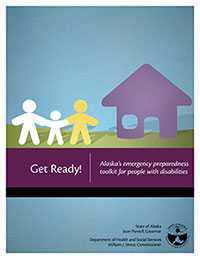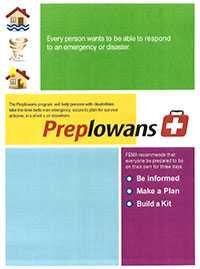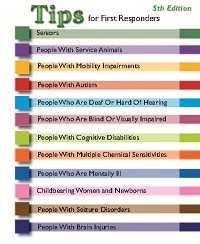Tools and Resources
It is critical to educate and provide training not only to people with disabilities and their caregivers, but also to emergency planners, first responders, and other members of the community who play an important role in making sure that people with disabilities are included in emergency preparedness and response plans. States have developed tools and resources to reach out to community members.
Resources for People with Disabilities and their Caregivers
Several states have available brochures, booklets, guides and other materials and tools that people with disabilities and their caregivers can use to prepare for an emergency.
Alaska

The Get Ready! Toolkit: This toolkit helps people with disabilities prepare for an emergency. Making an emergency plan and putting together an emergency kit is a big job. A good plan may include family, friends, neighbors, and organizations that support people with disabilities and can help make decisions.
Get Ready! Toolkit Webinar: This webinar was developed to assist Alaskans and others with disabilities and their caregivers in putting the Get Ready! Toolkit into action.
Disaster Preparedness for Families of Children and Youth with Special Health Care Needs: This guide takes parents through the basic steps of creating an emergency kit and developing a family communication plan.
Emergency Preparedness for All: This 10-minute video assists people with disabilities and their families in preparing for a disaster. The video is signed in American Sign Language (ASL), captioned (optional), and voiced in order to be the most accessible.
Arkansas
The 2016 emergency preparedness calendar and guide: This calendar was designed with seasonal tips and activities to help people with disabilities become more prepared for emergency situations.
Make Your Plan BEFORE a Disaster: This product contains information on access and functional needs for use in developing agency or individual preparedness plans and working with local emergency management. This booklet covers the Communication, Medical, Independence, Supervision, Transportation (C-MIST) planning guidelines to develop emergency plans for individuals with disabilities.
Iowa

Prep Iowans Program: This program was designed to help persons with disabilities take the time before an emergency occurs to plan for survival at home, in a shelter, or elsewhere.
IOWA Personal Emergency Preparedness Planning Guide for People with Access and Functional Needs:
This guide can be used to assist individuals with disabilities and their caregivers in developing personal emergency plans.
Kansas
The Preparedness Lifestyle. How to Plan for Seasonal and Pandemic Flu and Other Emergencies for People with Disabilities: This booklet is designed to help people with disabilities prepare for all hazards, which include public health threats and natural or man-made disasters.
Individual Disaster Preparedness: This poster, with a disaster do’s and don’ts checklist, can be displayed on shelters, business lobbies and other appropriate areas to indicate what people with disabilities can do to prepare for emergencies and disasters.
Community Disaster Preparedness: This poster, with a disaster do’s and don’ts checklist, can be displayed on shelters, business lobbies and other appropriate areas to indicate how people with disabilities can work with their communities to obtain the support they need during an emergency or disaster.
Montana
Emergency Medical Information (EMI) kit: This kit was designed to improve communications about medical needs during a disaster. The kit also promotes awareness of Smart911 and offers support for people with disabilities who may need help creating their profiles, as well as provides information about available emergency preparedness materials. The kit materials include an Emergency Medical Information form, a plastic bag to keep the form safe and let responders know the person has signed up for Smart911, and a magnetic hook.
Emergency Preparedness – An inclusive Guide for People with Access & Functional Needs: The purpose of this resource is to improve communications that promote the involvement and safety of persons with functional disabilities during emergency preparedness, action, and recovery.
New Hampshire
Emergency Preparedness & You: This is a brochure created to remind people with disabilities that disasters and emergencies can happen without warning, and it provides tips on planning and preparedness.
C-MIST Personal Planning Tool: This tool was created to assist people with disabilities in considering which specialized items to add to the Stay Kit and Go Bag, available at ReadyNH.gov, and the tool guides them through the creation of a personalized Emergency Plan.” With “This tool was created to assists people with disabilities in considering what specialized items to add to an emergency kit, and guides them through the creation of a personalized emergency plan.
You can visit New Hampshire’s emergency preparedness website to learn more about their local resources.
New York
Emergency Preparedness: My Safety, My Responsibility, My Plan: The New York Disability and Health Program partnered with the Westchester Institute for Human Development to promote this multi-session program to train adults with intellectual disabilities to understand and to be prepared for emergencies. Information is based on the principles set by the Federal Emergency Management Agency (FEMA), the Department of Homeland Security, the American Red Cross and the U.S. Fire Administration.
North Dakota
In an Emergency, Will You Be Ready? This 5-minute emergency preparedness video illustrates emergency preparation steps that include developing a plan, creating an emergency kit, and discussing specific considerations for people with disabilities.
Oregon

“Ready Now!” Toolkit: This is a resource for people with disabilities that emphasizes independence, allowing each person to address his or her specific needs. Topics include
- Identifying emergency situations and hazards.
- How an emergency may change his or her abilities and independence.
- The importance of developing a personal contact list.
- Assembling a 72-hour supply kit of food, water, special medications, and personal supplies.
- Preparing pets and service animals for emergencies.
- Developing evacuation plans.
- The importance of regularly updating emergency preparedness plans.
This guide is also available in Spanish.
South Carolina
Emergencies, Disasters and your Assistive Technology: South Carolina Disability and Health Program has provided emergency preparedness training to people with disabilities through their Independent Living Centers, the Spinal Cord Injury Association peer support groups, and Aging and Disability Resource Centers. The slides from this training are available for others to use.
Resources for Emergency Managers
States have available materials and presentations that have been used to train emergency management agencies on how to develop plans that address the needs of people with disabilities in emergencies and disasters.
Arkansas
Access & Functional Needs Injects Flip Flops: These are disability related materials for use by local emergency planning personal in emergency exercises and drills – based on listening sessions with people with intellectual and developmental disabilities, their family members, and emergency responders.
Iowa
A Whole Community Approach to Disaster Planning and Management: This training is provided to county emergency managers and planners on identifying disability resources to improve communication and transportation for individuals with disabilities during a disaster.
Emergency Planning for People with Disability: Emergency managers, local public health agencies, and other community providers use this training to understand the needs of people with disabilities during emergencies and prepare and respond accordingly.
Kansas
Ready, Willing, & Able Internet Course: This FREE two hour course for personnel in health, emergency managers, response, relief, and disability fields covers disability etiquette, terminology, and communication and assistance techniques during disasters to assist persons with the following disabilities: sensory (difficulty seeing, hearing, smelling, touching, or tasting); physical (difficulty walking or climbing stairs, grasping or lifting objects, or not being able to use one or more arms or legs); and cognitive (difficulty concentrating, remembering or making decisions). Login into TRAIN system to access the Ready, Willing, & Able – Disaster Preparedness and Response Course on Meeting the Needs of Persons with Disabilities (1020884)
Montana
Montana’s Community County Profiles: After assessing the needs of people with disabilities in the state’s counties, Montana’s Disability and Health Program shared results with emergency managers to help them improve their emergency plans and address the specific needs of their communities.
New Hampshire
Including People with Disabilities in Emergency Planning and Preparedness: This is a resource packet for state and local emergency management personnel or others involved with the planning or provisions of emergency operations. These resources were used to create a catalog of training modules from which local and regional emergency personnel could select a customized menu of topics to be covered in in-person trainings.
Ohio
Disability Training for First Responders Serving People with Disabilities: This training includes a video that provides information and best practices that help emergency planners ensure the safety of people with disabilities and their own safety during emergency events.
Oregon
Planning for Disasters with People with Disabilities: This material for professional planners and disability organizations advises them on why it is important to integrate people with disabilities into disaster planning and how to do so.
Resources for First Responders
First responders know well how to act during emergencies and disasters. However, they may need additional training to address the specific needs of people with disabilities.
Alabama
Tips for Providing Services for Individuals Living with Functional & Access Needs: This brochure offers valuable tips for providing services for individuals living with functional and access needs.
Alaska
Hidden Disabilities: Communication Tips for First Responders: This training video was created by a group of community partners to teach first responders how to communicate with people with different types of disabilities.
New Mexico

Tips for First Responders: Simple, easy-to-use tip sheet with information for assisting people with a wide range of disabilities. Originally developed by the University of New Mexico’s Center for Development and Disability, this tip sheet is now being distributed around the country by other State Disability and Health Programs.
Ohio
Disability Training for First Responders Serving People with Disabilities: This training includes a video that provides information and best practices to help first responders ensure the safety of people with disabilities and their own safety during emergency events.
Serving Service Animal Team: This video developed by the Ohio Trauma Committee Functional Needs Work group teaches first responders how to handle service animals in emergency situations.
Oregon
Engaging People with Access and Functional Needs during Disasters: This training was provided statewide to Community Emergency Response Teams (CERT), Medical Reserve Corp and other first responder organizations. It has information that first responders can use to respond to the needs of people with disabilities during a disaster or emergency. Topics include considerations on how to reunite people with disabilities with their loved ones, keeping equipment with individuals, and how to develop creative strategies to help communicate and provide access to resources.
Resources for Community-based Organizations
Community-based organizations, such as Centers for Independent Living (CILs), Aging and Disability Resource Centers (ADRCs), and other entities that regularly provide services to people with disabilities need to know how to plan for emergencies and disasters.
Arkansas
Overview of Emergency Management for Disability Programs: This training curriculum developed for community members, such as service providers for the elderly and people with disabilities, Centers for Independent Living staff, and local emergency managers, has information that will lead to cooperative planning and appropriate response.
Montana
Whole Community Approach – Emergency & Disaster Preparedness: This material can help community-based organizations fulfill their role on making sure people with disabilities are well informed and have the resources they need to stay safe during emergencies and disasters.
New Hampshire
Creating Emergency Kits and Plans with People with Disabilities: This interactive training curriculum teaches staff from disability organizations, family members, and people with disabilities how to be personally prepared for emergencies. During the training, participants review basic, modified, and specialized emergency supply kit items, and learn how to use the C-MIST Personal Planning Tool to make individual emergency plans.
North Dakota
North Dakota’s Disaster Preparedness: This emergency preparedness training can be used by Centers for Independent Living and other healthcare providers to make sure that people with disabilities are prepared for emergencies and disasters.
Emergency Preparedness for Vulnerable Populations: North Dakota Disability and Health Program provided training to community-based organizations to help them respond to the needs of people with disabilities during disasters and emergencies. Slides from this training are available on the program’s website.
- Page last reviewed: August 3, 2017
- Page last updated: August 3, 2017
- Content source:




 ShareCompartir
ShareCompartir